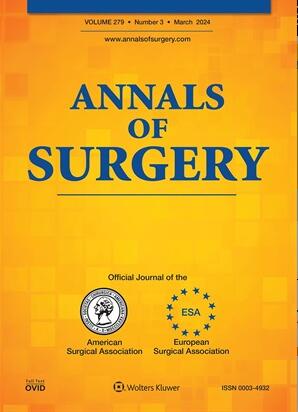结果的比较评估:左侧胰腺切除术后腹腔引流管与无腹腔引流管的比较--系统性回顾和 Meta 分析。
IF 7.5
1区 医学
Q1 SURGERY
引用次数: 0
摘要
目的本系统综述和荟萃分析旨在比较胰腺切除术后放置腹腔引流管和不放置引流管的结果。背景左侧胰腺切除术(LP)是一种常用于治疗各种胰腺疾病的外科手术,通常与术后并发症(如术后胰瘘(POPF))相关。方法在 PubMed、Cochrane 和 Embase 上进行了从开始到 2024 年 3 月 15 日的全面检索,共获得 9 项研究,包括 15,817 名患者。数据提取自报告主要和次要结果的随机和非随机研究。分析在 Revman 中进行。结果共有 13081 名患者在左侧胰腺切除术后接受了引流管置入术,2736 名患者被纳入无引流管组。其中男性患者占 45.1%(n=7140),引流管组男性患者占 45.9%(n=6012),无引流管组男性患者占 41.2%(n=1128)。无引流组的主要发病率(定义为 Clavien-Dindo ≥III 级并发症)显著较低(相对风险 [RR]:0.77,95% 置信区间 [CI]:0.64-0.93,P=0.006)。同样,无引流组术后胰瘘(POPF)(RR:0.51,95% CI:0.38-0.67,P<0.00001)、再入院(RR:0.75,95% CI:0.59-0.96,P=0.02)和手术部位感染(RR:0.82,95% CI:0.70-0.95,P=0.009)的发生率也较低。结论左侧胰腺切除术后常规引流与并发症减少和住院时间缩短有关,支持其在改善术后预后方面的潜在益处。本文章由计算机程序翻译,如有差异,请以英文原文为准。
Comparative Assessment of Outcomes: Abdominal Drain vs. No Abdominal Drain after Left Pancreatectomy-A Systematic Review and Meta-Analysis.
OBJECTIVE
This systematic review and meta-analysis aimed to compare outcomes between abdominal drain placement and no drain placement post-pancreatectomy.
BACKGROUND
Left pancreatectomy (LP) is a surgical procedure commonly employed for various pancreatic conditions, often associated with postoperative complications like post-operative pancreatic fistula (POPF). While routine abdominal drainage following LP has been standard practice, recent evidence suggests potential benefits of omitting this approach.
METHODS
A comprehensive search was conducted on PubMed, Cochrane, and Embase from inception up to 15 March 2024, yielding nine studies comprising 15,817 patients. Data were extracted from randomized and non-randomized studies reporting primary and secondary outcomes. The analysis was performed in Revman. Risk ratios were calculated with 95% confidence intervals, and a P-value of <0.05 was considered statistically significant.
RESULTS
A total of 13,081 patients underwent drain placement after left pancreatectomy, and 2,736 patients were included in the no-drain group. Out of the total, 45.1% (n=7140) patients were male, with 45.9% (n=6012) males in the drain group and 41.2% (n=1128) males in the no-drain group. Major morbidity, defined as Clavien-Dindo grade ≥III complications, was significantly lower in the no-drain group (relative risk [RR]: 0.77, 95% confidence interval [CI]: 0.64-0.93, P=0.006). Similarly, lower rates of postoperative pancreatic fistula (POPF) (RR: 0.51, 95% CI: 0.38-0.67, P<0.00001), readmission (RR: 0.75, 95% CI: 0.59-0.96, P=0.02), and surgical site infections (RR: 0.82, 95% CI: 0.70-0.95, P=0.009) were observed in the no-drain group. Additionally, a shorter length of hospital stay was noted in this group (mean difference MD: -1.65, 95% CI: -2.50 to -0.81, P=0.0001).
CONCLUSIONS
Omitting routine drainage after left pancreatectomy is associated with reduced complications and shorter hospital stays, supporting its potential benefits in improving postoperative outcomes.
求助全文
通过发布文献求助,成功后即可免费获取论文全文。
去求助
来源期刊

Annals of surgery
医学-外科
CiteScore
14.40
自引率
4.40%
发文量
687
审稿时长
4 months
期刊介绍:
The Annals of Surgery is a renowned surgery journal, recognized globally for its extensive scholarly references. It serves as a valuable resource for the international medical community by disseminating knowledge regarding important developments in surgical science and practice. Surgeons regularly turn to the Annals of Surgery to stay updated on innovative practices and techniques. The journal also offers special editorial features such as "Advances in Surgical Technique," offering timely coverage of ongoing clinical issues. Additionally, the journal publishes monthly review articles that address the latest concerns in surgical practice.
 求助内容:
求助内容: 应助结果提醒方式:
应助结果提醒方式:


